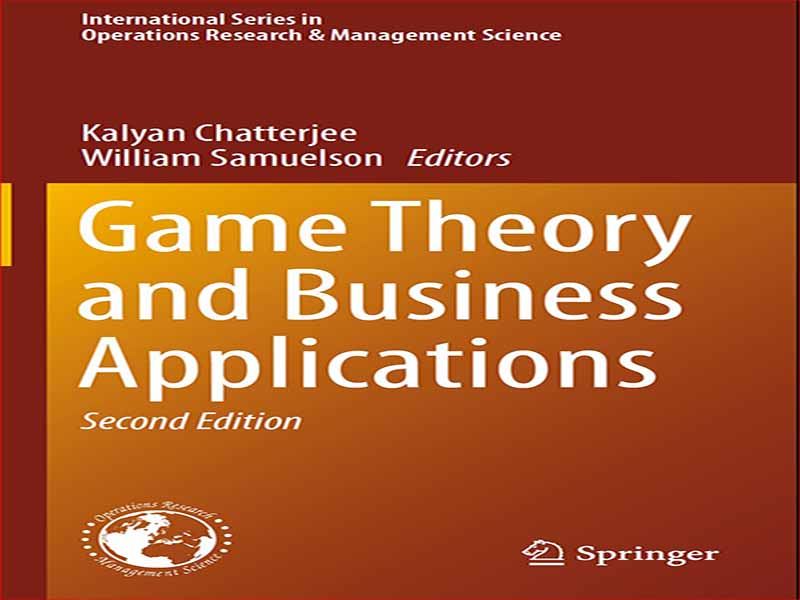- عنوان کتاب: Game Theory and Business Applications
- نویسنده: Kalyan Chatterjee
- حوزه: نظریه بازیها
- سال انتشار: 2014
- تعداد صفحه: 406
- زبان اصلی: انگلیسی
- نوع فایل: pdf
- حجم فایل: 2.90 مگابایت
مانند نسخه قبلی خود (چاترجی و ساموئلسون 2002)، هدف این نسخه جدید ارائه دیدگاهی گسترده و (امیدواریم) عمیق از روشی که میتوان تصمیمات تجاری را با استفاده از تئوری بازیها مدلسازی و تحلیل کرد، به خواننده علاقهمند ارائه کرد. محتویات فصل طیف گسترده ای از عملکردهای تجاری را در بر می گیرد – از حسابداری گرفته تا امور مالی تا عملیات و بازاریابی و طراحی سازمانی. علاوه بر این، حوزه های کاربردی خاص شامل استراتژی های تحقیق و توسعه، چانه زنی، مذاکرات حل و فصل در سایه دعوی قضایی، رفتار استراتژیک در تنظیمات قانونی، مسائل قراردادی در بازار کار دانشگاهی، مزایده ها و مناقصه رقابتی، و اقتصاد تجربی است. همه این برنامهها شامل تنظیمات تصمیمگیری رقابتی میشوند – یعنی شرایطی که تعدادی از عوامل اقتصادی در تعقیب منافع شخصی مربوطه خود اقداماتی را انجام میدهند که روی هم بر همه ثروت آنها تأثیر میگذارد. در زبان تئوری بازی، بازیکنان اقداماتی را انجام میدهند که مطابق با «قوانین بازی» باشد و این اقدامات مشترک، نتایج و بازده نهایی را تعیین میکنند. نظریه بازی علاوه بر ارائه ساختاری که در آن تنظیمات رقابتی مدلسازی میشود، راه درازی را برای پاسخ به این سوال کلیدی پیش میبرد: رقیب چه تصمیم یا اقدام بهینهای باید اتخاذ کند، در حالی که اقدامات بهینه رقبا را پیشبینی میکند؟ به شرطی که توصیف تئوری بازی به طور صادقانه موقعیت رقابتی در دنیای واقعی را در دست داشته باشد، نظریه بازی راهنمای قانعکنندهای برای استراتژی کسبوکار ارائه میکند. از بدو تولد با فون نویمان و مورگنسترن، نظریه بازی ها و رفتار اقتصادی (1944)، و برای 25 سال بعدی، نظریه بازی اصولاً یک رشته ریاضی بود. مطمئناً، مفاهیم راه حل ظریفی توسعه یافته اند – اما برای یک کلاس نسبتاً محدود تنظیمات (مانند بازی های حاصل جمع صفر). با این حال، در 30 سال گذشته، تئوری بازی برای تعداد فزاینده ای از مشکلات عملی به کار گرفته شده است: از تجزیه و تحلیل ضد تراست تا سیاست پولی. از طراحی موسسات حراج تا ساختار انگیزه ها در شرکت ها؛ از مسابقات ثبت اختراع تا حل اختلاف. تئوری بازی ها جزء اصلی مطالعات دکترا در اقتصاد، امور مالی و علوم مدیریت است. در واقع، متون بسیار عالی در این زمینه وجود دارد: فودنبرگ و تیرول (1991)، آزبورن و روبینشتاین (1994)، میرسون (1997)، راسموسن (2006)، یا دیکسیت و همکاران. (2009) به نام چند. شاید فشارسنج بهتری از اهمیت فزاینده ایدههای نظری بازی در تجارت و مدیریت، جایگاه رو به رشد این رشته در متون رایج در استراتژی، اقتصاد خرد و اقتصاد مدیریتی باشد. از این میان می توان به Milgrom and Roberts (1992)، McAfee (2005) و Besanko و همکاران اشاره کرد. (2012). علاوه بر اقتصاد، استراتژی و امور مالی، حوزه بازاریابی نیز منطقه ای مناسب برای کاربردهای نظری بازی بوده است. به عنوان مثال، ورنرفلت (1995) و بگول (2007) را ببینید. همانطور که توسط Sridhar Moorthy در فصل. 4، تجزیه و تحلیل کلمات کلیدی از 2300 مقاله منتشر شده در علم بازاریابی بین سالهای 1982 تا 2011 نشان میدهد که «نظریه بازیها دومین کلمه کلیدی محبوب پس از «قیمتگذاری» است. در مقابل، 30 سال پیش، نظریه بازی ها در اکثر کتاب های درسی و بیشتر کارهای تحقیقاتی غایب بود. فصلهای این ویرایش دوم برخی از جالبترین کاربردهای تئوری بازیها را در شرایط غیر فنی بیان میکنند. فصل های 2، 3، و 7 از چاپ اول باقی مانده است، در حالی که فصل ها. 5، 6، 13، و 14 به طور گسترده اصلاح و به روز شده اند تا تحقیقات جدید را در دهه گذشته منعکس کنند. شش فصل باقیمانده، مشارکتهای جدید و بدیع است که استراتژیهای بازاریابی، تحقیق و توسعه، توافقنامههای خارج از دادگاه، حقوق و اقتصاد، نقش تصدی آکادمیک، و اقتصاد تجربی را پوشش میدهد. پیشفرض میگیریم که خواننده از مفاهیم و نتایج اساسی نظری بازیها دانش عملی داشته باشد: از تعادل نش و بیزی، تا خطر اخلاقی و انتخاب نامطلوب. (هر یک از متون تئوری بازی و اقتصاد ذکر شده در بالا مکان مناسبی برای استفاده مجدد برای تقویت ابزارهای اساسی است.) بخش اول این جلد کاربردهای تئوری بازی را در پنج حوزه عملکردی تجارت مورد بحث قرار می دهد: مالی، حسابداری، بازاریابی، عملیات. سیستم های مدیریت و اطلاعات و طراحی سازمان. بخش دوم کاربردهای مهمی از جمله رفتار استراتژیک در تنظیمات چانه زنی و تنظیمات قانونی، نهاد خاص دوره تصدی آکادمیک، مزایده ها و موسسات مناقصه رقابتی و اقتصاد تجربی را در نظر می گیرد. تاکید بر نقش تئوری بازی ها در تئوری و عمل است. ناگفته نماند که هیچ کتاب واحدی نمی تواند سهم تئوری بازی ها را در تمام جنبه های تجارت داشته باشد. از این جلد حوزههای موضوعی مهمی مانند: مقررات (از جمله اقدامات ضد تراست)، جنبههای استراتژیک بحران مالی اخیر، و کاربردهای تجارت الکترونیک حذف شدهاند.
Like its predecessor (Chatterjee and Samuelson 2002), the aim of this new edition is to provide the interested reader a broad and (we hope) deep view of the way business decisions can be modelled and analyzed using game theory. The chapter contents embrace a wide variety of business functions – from accounting to finance to operations to marketing to organizational design. Moreover, specific application areas include R&D strategies, bargaining, settlement negotiations in the shadow of litigation, strategic behavior in legal settings, contractual issues in the academic labor market, auctions and competitive bidding, and experimental economics. All of these applications involve competitive decision settings – that is to say, situations where a number of economic agents in pursuit of their respective self-interests take actions that together affect all of their fortunes. In the language of game theory, players take actions consistent with the given “rules of the game,” and these joint actions determine final outcomes and payoffs. Besides providing a structure in which tomodel competitive settings, game theory goes a longway toward answering the key question: What optimal decision or action should a competitor take, all the while anticipating optimal actions from one’s rivals? Provided the game-theoretic description faithfully captures the real-world competitive situation at hand, game theory provides a compelling guide for business strategy. From its birth with von Neumann and Morgenstern’s, Theory of Games and Economic Behavior (1944), and for its next 25 years, game theory was principally a mathematical discipline. To be sure, elegant solution concepts were developed – but for a relatively limited class of settings (such as zero-sum games). In the last 30 years, however, game theory has been applied to a growing number of practical problems: from antitrust analysis to monetary policy; from the design of auction institutions to the structuring of incentives within firms; from patent races to dispute resolution. Game theory is a staple of doctoral studies in economics, finance, and management science. Indeed, there are many excellent texts in the subject: Fudenberg and Tirole (1991), Osborne and Rubinstein (1994), Myerson (1997) Rasmusen (2006), or Dixit et al. (2009) to name a few. Perhaps, a better barometer of the growing importance of game-theoretic ideas in business and management is the growing place of the discipline in mainstream texts in strategy, microeconomics, and managerial economics. Notable among these are Milgrom and Roberts (1992), McAfee (2005), and Besanko et al. (2012). Besides economics, strategy, and finance, the marketing area has also been a fertile area for gametheoretic applications. See, for example,Wernerfelt (1995) and Bagwell (2007). As noted by Sridhar Moorthy in Chap. 4, an analysis of key words of 2,300 articles published in marketing science between 1982 and 2011 shows “game theory to be the second most popular key word after ‘pricing’.” By contrast, 30 years ago, game theory was absent from most textbooks and most research work. The chapters of this second edition outline some of the most interesting applications of game theory in non-technical terms. Chapters 2, 3, and 7 are retained from the first edition, while Chaps. 5, 6, 13, and 14 have been extensively revised and updated to reflect new research over the last decade. The remaining six chapters are new and original contributions covering marketing, research and development strategies, out-of-court settlements, law and economics, the role of academic tenure, and experimental economics. We presuppose that the reader has a working knowledge of basic game-theoretic concepts and results: from Nash and Bayesian equilibrium, to moral hazard and adverse selection. (Any of the game theory and economics texts cited above are good places to turn for re-enforcing the basic tools.) The first section of this volume discusses game-theoretic applications in five functional areas of business: finance, accounting, marketing, operations management and information systems, and organization design. The second section considers important applications including strategic behavior in bargaining settings and legal settings, the peculiar institution of academic tenure, auctions and competitive bidding institutions, and experimental economics. The emphasis is on the contributions of game theory to both theory and practice. It goes without saying that no single book can include the contributions of game theory in all aspects of business. Omitted from this volume are such important topic areas as: regulation (including antitrust practices), strategic aspects of the recent financial crisis, and ecommerce applications.
این کتاب را میتوانید از لینک زیر بصورت رایگان دانلود کنید:
Download: Game Theory and Business Applications




































نظرات کاربران